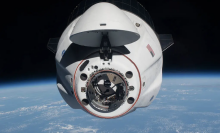There are funhouse mirrors in space.
Objects in the universe can be so massive — often clusters of galaxies — that they warp the cosmos, like a bowling ball sitting on a mattress. This creates a curved cosmic lens, bending and distorting light, while also magnifying and brightening the light. It's an invaluable natural telescope for astronomers, and researchers have recently discovered an extremely potent such lens (also called a "gravitational lens").
From our view on Earth, it's a rare alignment of galaxies. There's a foreground cluster of galaxies (the lens) located some 5 billion light-years away, and behind that, there's an impressive line of seven galaxies.
"This is an amazingly lucky ‘galactic line-up’ – a chance alignment of multiple galaxies across a line-of-sight spanning most of the observable universe," David Schlegel, an astrophysicist at Lawrence Berkeley National Lab who coauthored the research, said in a statement. "Finding one such alignment is a needle in the haystack. Finding all of these is like 8 needles precisely lined up inside that haystack."
The research recently published in the peer-reviewed journal The Astrophysical Journal. This unusual, warped cluster makes impossible deep space observations a reality. "By virtue of its ability to drastically magnify background sources, strong lensing allows for significantly deeper and further observations than otherwise possible," the researchers wrote.
The cluster is labeled below. Here's what you're seeing:
- The cosmic lens: The most massive four galaxies in this weighty foreground cluster, 5 billion light-years away, are labeled "La, Lb, Lc, and Ld." For reference, a single light-year is nearly 6 trillion miles.
- Magnified galaxies: These distant galaxies, located between 7.6 to 12 billion light-years away (that's quite far; the oldest light in the galaxy is some 13.8 billion years old), are labeled 1 through 7. But they appear numerous times, as they're warped around the lens. Each repeated appearance is given a letter.
- Giant Einstein Cross: "Of particular interest is the discovery of an Einstein Cross – the largest known to date – shown in galaxy number 4’s multiple appearances (indicated by 4a, 4b, 4c, and 4d)," the lab wrote. "This rare configuration of multiple images around the center of the lens is an indication of the symmetrical distribution of the lens’ mass (dominated by invisible dark matter) and plays a key role in the lens-modeling process."

It's been dubbed the "Carousel Lens," because the background galaxies form circular structures around the center, similar to a carousel. It wasn't easy to find. Observations from multiple telescopes and observatories, such as the NASA Hubble Space Telescope and The Dark Energy Spectroscopic Instrument (DESI), helped locate the lens and confirm its magnifying abilities.
"Clearly, there is much more to be learned from this system," the researchers wrote. "The coincidental alignment of seven galaxies and a foreground galaxy cluster can give us unprecedented insight into the Universe, whether it be high-redshift galaxies, cluster properties, or cosmology."
Topics NASA













